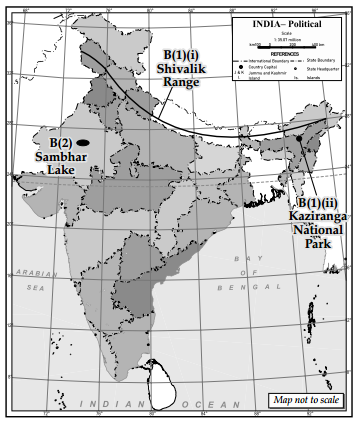Students must start practicing the questions from CBSE Sample Papers for class 9 Social Science with Solutions Set 4 are designed as per the revised syllabus.
CBSE Sample Papers for Class 9 Social Science Set 4 with Solutions
Time Allowed: 3 hours
Maximum Marks: 80
General Instructions:
- Question paper comprises five Sections – A, B, C, D, and E. There are 37 questions in the question paper. All questions are compulsory.
- Section A – From questions 1 to 20 are MCQs of 1 mark each.
- Section B – Questions no. 21 to 24 are Very Short Answer Type Questions, carrying 2 marks each. The answer to each question should not exceed 40 words.
- Section C – Questions no. 25 to 29 are Short Answer Type Questions, carrying 3 marks each. The answer to each question should not exceed 60 words.
- Section D – Questions no. 30 to 33 are Long Answer Type Questions, carrying 5 marks each. Answer to each question should not exceed 120 words.
- Section E – Questions no. from 34 to 36 are Case Based Questions with three sub-questions and are of 4 marks each.
- Section F – Question no. 37 is Map-based, carrying 5 marks with two parts. 37a from History (2 marks) and 37b from
Geography (3 marks). - There is no overall choice in the question paper. However, an internal choice has been provided in a few questions. Only one of the choices in such questions has to be attempted.
- In addition to this, separate instructions are given with each section and question, wherever necessary.
Section-A
MCQs
(1 x 20 = 20 Marks)
Question 1.
Which country experienced a revolution Prior to 1857? [1]
(A) India
(B) France
(C) Both experienced a revolution
(D) Neither experienced a revolution
Answer:
Option (B) is correct.
Explanation: France experienced a revolution prior to 1857, the conditions in France led to a revolution that brought irreversible changes to the country.
Question 2.
Which of the following port city/cities owed it ¡sí their economic prosperity to the flourishing slave trade? [1]
(A) Bordeaux
(B) Paris
(C) Nantes
(D) Both (A) and (C)
Answer:
Option (D) is correct.
Explanation: French merchants sailed from the ports of Bordeaux or Nantes to the African coast, where they bought slaves from local chieftains.
Question 3.
Look at the picture and identify the correct option: [1]
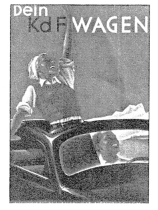
(A) Your Volkswagen
(B) Freedom is Ours
(C) Free and Young Germany
(D) None of these
Answer:
Option (A) is correct.
Explanation: Such posters suggested that owning a car was no longer just a dream for an ordinary worker.
Question 4.
………….. was a natural scientist who tried to explain the creation of plants and animals through the concept of evolution and natural selection. [1]
(A) Hitler
(B) Darwin
(C) Herbert Spencer
(D) None of these
Answer:
(B) Darwin
Question 5.
Look at the Table: India: Sex Ratio 1951-2011 [1]
| Census year | Sex ratio (Females per 1,000 Males) |
| 1951 | 946 |
| 1961 | 941 |
| 1971 | 930 |
| 1981 | 934 |
| 1991 | 929 |
| 2001 | 933 |
| 2011 | 943 |
What is the sex ratio of females (per 1,000 Males) in the year 1961?
(A) 946
(B) 941
(C) 930
(D) 93
Answer:
(B) 941
Question 6.
A statement of Assertion (A) is followed by a statement of Reason (R). [1]
Assertion (A): A well-educated healthy population provides potential power.
Reason (R): People are the nation’s most valuable resource.
Mark the correct choice as
(A) Both Assertion (A) and Reason (R) are hue, and Reason (R) is the correct explanation of Assertion (A).
(B) Both Assertion (A) and Reason (R) are true, but Reason (R) is not the correct explanation of Assertion (A).
(C) Assertion (A) is true, but Reason (R) is false.
(D) Assertion (A) is false, but Reason (R) is true. (1]
Answer:
Option (A) is correct
Explanation: A well-educated healthy population is important for economic growth, poverty reduction, and reducing inequality. By investing in these areas a country can create a more prosperous and equitable society for all.
Question 7.
Monsoon arrives in India approximately in: [1]
(A) Early May
(B) Early July
(C) Early June
(D) Early August
Answer:
(B) Early July
Question 8.
A statement of Assertion (A) is followed by a statement of Reason (R). [1]
Assertion (A): The non-whites did not have the voting rights.
Reason (R): The white rulers treated non-whites as inferiors.
Mark the correct choice as:
(A) Both Assertion (A) and Reason (R) are true, and Reason (R) is the correct explanation of Assertion (A).
(B) Both Assertion (A) and Reason (R) are true, but Reason (R) is not the correct explanation of Assertion (A).
(C) Assertion (A) is true, but Reason (R) is false.
(D) Assertion (A) is false, but Reason (R) is true.
Answer:
Option (A) is correct
Explanation: The apartheid system was particularly oppressive for the blacks.
Question 9.
Study the given picture carefully
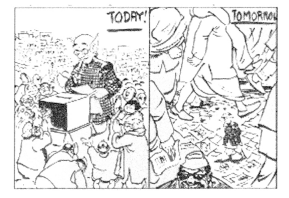
This picture is related to which of the following: [1]
(A) Public distribution system
(B) Election
(C) Famine
(D) None of these
Answer:
(B) Election
Question 10.
What is meant by the political executive? [1]
(A) The Speaker
(B) Political leaders who are elected by the people for a specific term.
(C) Only those political leaders who are in the ruling party.
(D) Only those political leaders who are in the opposition party.
Answer:
Option (B) is correct.
Explanation: The President of India is like the Queen of Britain whose functions are to a large extent ceremonial. The President supervises the overall functioning of all the political institutions in the country so that they operate in harmony to achieve
the objectives of the State. Political executives are those which are representatives of the people and are elected by the people through an electoral process.
Question 11.
Which institution is empowered to administer justice in India? [1]
(A) Legislature
(B) Executive
(C) Judiciary
(D) Ruling party
Answer:
(C) Judiciary
Question 12.
Match the following Column A with Column B [1]
| Column-A | Column-B |
| (a) 1999 | (i) General Pervez Musharraf led a military coup |
| (b) 1930 | (ii) Mexico got its independence |
| (c) until 2015 | (iii) Saudi Arabia women did not have the right to vote |
| (d) 1980 | (iv) Zimbabwe attained independence from White minority rule |
Options:
(A) a-i, b-ii, c-iii, d-iv
(B) a-ii, b-i, c-iv, d-iii
(C) a-i, b-ii, c-iii, d-iv
(D) a-iv, b-i, c-ii, d-iii
Answer:
(A) a-i, b-ii, c-iii, d-iv
Question 13.
Who were treated as inferiors in South Africa? [1]
(A) Blacks
(B) Coloured
(C) Whites
(D) Both (A) and (B)
Answer:
(D) Both (A) and (B)
Question 14.
A statement of Assertion (A) is followed by a statement of Reason (R).
Assertion (A): It is becoming clear that there is a strong link between economic growth and poverty reduction.
Reason (R): Over a period of thirty years lasting up to the early eighties, there were little per capita income
growth and not much reduction in poverty.
Mark the correct choice as:
(A) Both Assertion (A) and Reason (R) are true, and Reason (R) is the correct explanation of Assertion (A).
(B) Both Assertion (A) and Reason (R) are true, but Reason (R) is not the correct explanation of Assertion (A).
(C) Assertion (A) is true, but Reason (R) is false.
(D) Assertion (A) is false, but Reason (R) is true. [1]
Answer:
Option (B) is correct.
Explanation: Economic growth widens opportunities and provides the resources needed to invest in human development.
Question 15.
Raj’s mother looked after domestic chores. She was involved in which of the following activities? [1]
(A) Economic activity
(B) Non-economic activity
(C) Market Activity
(D) None of these
Answer:
Option (B) is correct
Explanation: Activities which are not meant for monetary gains and their purpose is just to serve are known as non-economic activities.
Question 16.
‘Sarva Shiksha Abhiyan’ is a significant step towards providing elementary education to all children in the age group of …………… . [1]
(A) 6-12
(B) 6-10
(C) 8-14
(D) 6-14
Answer:
Option (D) is correct.
Explanation: The Abhiyan started to provide the elementary education for the age group 6-14 years.
Question 17.
What kind of people are a liability for the economy?
(A) Poor
(B) Healthy
(C) Elite
(D) illiterate
Answer:
Option (D) is correct.
Explanation: Illiterate people are lack in education and skills.
Question 18.
The poverty line surveys are conducted by ……………………. . [1]
(A) National Statistical Organisation
(B) National Sample Survey Organisation
(C) National State Organisation.
(D) National Sustainable Organisation
Answer:
(B) National Sample Survey Organisation
Question 19.
Find the incorrect option: [1]
(A) One of the social indicators of poverty is social exclusion.
(B) Poor people are more vulnerable to the ill effects of natural calamities.
(C) Size of the family cannot lead to poverty.
(D) Child labour is an effect of poverty.
Answer:
(C) Size of the family cannot lead to poverty.
Question 20.
Animal husbandry, fishing, poultry farming, activities can be undertaken in which of the following sectors? [1]
(A) Primary
(B) Secondary
(C) Tertiary
(D) None of these
Answer:
(A) Primary
Section-B
Very Short Answer Questions
(2 x 4 = 8 Marks)
Question 21.
Describe the status of the nobles in France before the revolution. What was the subsistence crisis? Why did it occur in France during the Old Regime? [2]
Answer:
The clergy and the nobles led a life of luxury and enjoyed many privileges. Whereas, the peasants and workers lived a miserable life. They had to pay heavy taxes and were forced into labour. The middle – class comprising lawyers, doctors, teachers, etc. also
suffered humiliation at the hands of the dirty and the nobles.
Definition- Subsistence crisis can be defined as an extreme situation where the basic means of livelihood are endangered.
Reason- The population of France was on the rise. It rose from 23 million in 1715 to 28 million in 1789. This led to an increase in the demand for food grains. The production of food grains could not keep in place with the demand and the price of bread which was the staple diet of the majority rose rapidly. The wages also did not keep pace with the rise in prices. This led to the subsistence crisis in France.
Question 22.
If you visit Kavaratti Island, which Union Territory of India you will be going to? Mention its location. [2]
Answer:
- Lakshadweep
- It lies in the Arabian Sea
- It is situated approximately 400 km off India’s west coast.
Question 23.
What factors helped the Indian leaders to develop the Indian Constitution? Explain any two. [2]
Answer:
Factors:
- Ideals of the French Revolution
- Parliamentary democracy in Britain
- Bill of Rights in the U.S.
Question 24.
Define vulnerability. [2]
Answer:
Vulnerability is determined by the availability of options for employment, education, healthcare, etc. Poor people are more vulnerable to poverty.
Section-C
Short Answer-Based Questions
(3 x 5 = 15 Marks)
Question 25.
How was the French Revolution responsible for the societal changes? [3]
Answer:
The French Revolution opened up the possibility of creating a dramatic change in the way society was structured. Before the 18th century, the French society was broadly divided into Estates and Orders. An aristocracy of the Church ended. Economic and social power was controlled. New ideas about individual rights and the question as to who controlled social powers were discussed.
Question 26.
What is Dependency Ratio? Why is Dependency Ratio higher in India? [3]
Answer:
The ratio of people of dependent age (below 15 years and above 60 years) to people of economically active ages (15-59 years) is called Dependency Ratio. The Dependency Ratio is higher in India because a larger number of children (34.4%) and aged population (6.9%) are found dependent upon the working population (58.7%). The economically unproductive population needs food, clothing, education, and medicare which has to be provided by the working population.
Question 27.
Define the following:
(a) Universal Adult Franchise
(b) Election Photo Identify Card
(c) Voter’s list [3]
Answer:
(a)’ Universal Adult Franchise: It is a right granted to all adults – men or women, rich or poor, white or black, to vote for their representatives to run the government. In practice, it means that everyone should have one vote and each vote should have equal value.
(b) Election Photo Identify Card: This is introduced by the government to stop rigging. The voters are required to carry this card when they go out to vote so that no one can vote for someone else. The government has tried to give this card to every person on the voters list. But the card is not yet compulsory for voting.
(c) Voter’s List: In a democratic election, the list of those who are eligible to vote is prepared much before the election and given to everyone. This list is officially called the electoral roll and is commonly known as the Voters’ List.
Question 28.
What does unemployment mean? What types of unemployment exist in rural and urban areas? [3]
Answer:
Unemployment is said to exist when people who are willing to work at the given wages cannot find jobs.
In Rural Areas:
- Seasonal unemployment-When people don’t get jobs during some months of a year. For example, during harvesting time.
- Disguised unemployment-People appear to be employed. For example, a job requiring service of five people, but engaging eight people.
In Urban Areas: Urban areas have mostly educated and unemployed youth. It has become a common phenomenon. Many youths with matriculation, graduation, and post-graduation degrees are not able to find jobs. Unemployment of graduates and postgraduates has increased.
Question 29.
Discuss the trend of poverty in India since 1973.
OR
Describe how the poverty line is estimated in India. Or Explain some ways by which the poverty line is estimated in India. [3]
Answer:
A person is considered below the poverty line if his/her income or consumption level falls below a ‘minimum level’ necessary to fulfill basic needs. While determining the poverty line, a minimum level of food requirement, clothing, footwear, fuel, light, educational and medical requirements, etc are determined for subsistence. Estimating the poverty line is also based on the desired calories requirement. It is 2400 calories per person per day in the rural areas and 2100 calories in the urban areas.
There has been a substantial decline in poverty ratios in India from about 55 percent in 1973 to 36 percent in 1993. The proportion of people below the poverty line further came down to about 26 percent in 2000.
If the trend continues, people below the poverty line may come down to less than 20 percent in the next few years. Although, the percentage of people living under poverty line declined in the earlier two decades (1973 – 1993), yet the number of poor remained stable around 320 million for a fairly long period. The latest estimate indicates a significant reduction in the number of poor to about 26 million.
Section-D
Long Answer Based Questions
(5 x 4 = 20 Marks)
Question 30.
Explain the thoughts and beliefs of Karl Marx which convinced the workers to enter into conflict with the Capitalists. What were the conditions in Russia during the First World War? [5]
Answer:
- Industrial society was capitalist. The profit of capitalists was produced by workers.
- Conditions of workers could not improve till capitalists accumulated wealth.
- Workers should overthrow capitalism and private property.
- Workers should construct a radically socialist society where all property would be socially controlled. This would be a communist state.
- Karl Marx believed that all of this would help the workers win over the capitalists.
- Russia became a part of First World War in 1914. In the beginning, the war was popular. The Tsar refused to consult the main parties in the Duma. This led to weaken the support within Russia. Anti-German sentiments among the Russians were on an increase. St Petersburg, a German name was renamed as Petrograd.
- Russia’s armies suffered defeats in Germany and Austria between 1914 and 1916. Casualties were very high. Soldiers did not wish to fight such a war. The retreating Russian army destroyed crops and buildings to prevent them from being used by the enemies. This led to millions of refugees in Russia.
- The Tsar and the government were further discredited for the situation.
- The war also had a severe impact on industry. Russia had few industries and that too were cut off from suppliers of industrial goods by German control of the Baltic Sea. Industrial equipment began to disintegrate, railway lines began to break down.
Question 31.
Explain the significance of India’s eminent position in the Indian Ocean. [5]
OR
Distinguish between Bhabar and Terai.
Answer:
Significance:
- The Trans-Indian Ocean route connects countries of Europe in West.
- Countries of East Asia have provided a strategic central location to India.
- Deccan Plateau protrudes into the Indian Ocean. It helps to establish a close contact with West Asia, Africa, and Europe.
- No country other than India has such a long coastal line on the Indian Ocean which provides significance and favourable trading ports and commercial hubs for many MNCs and countries.
- The coastal regions of our country provide important hinterlands for the ports.
- The sea routes have contributed in the exchange of ideas and commodities.
- The ideas of Upartishads and Ramayana, Indian numerals and the decimal system could reach to many parts of the world.
- Spices, muslin, and other merchandise were taken to other countries.
- The influence of Greek sculpture and styles of domes and minarets can be seen in our country.
OR
| Bhabar | Terai |
| 1. It lies to the south of the Shivalik range. | The belt exist to the South of Bhabar area. |
| 2. The width ranges between 8 to 16 km. | It is almost parallel to the Bhabar. |
| 3. The area is highly coarse in nature due to many pebbles and ‘kankars’ found over here. | The area has highly fine sediments due to the deposition mad |
| 4. Vegetation found here is very less. | Very dense vegetation is found in Terai region. |
| 5. Main feature is that river disappears in the Bhabar region because big pores are present in it. | Since the river reemerges back in this region, the area becomes highly swampy and marshy. |
Question 32.
Explain the importance of an institutional design of the Constitution of India.
OR
Describe the role of the Election Commission in holding free and fair elections in India. [5]
Answer:
- The Indian Constitution is a detailed document. It needs to be amended to keep it updated. It has provisions to incorporate changes from time to time. These changes are called ‘constitutional amendments.’
- It lays down the procedure for choosing a representative to govern the country.
- It defines ‘who will have how much power to take a particular decision’.
- It also limits the powers of the government by providing some rights to the citizens which cannot be violated.
- It describes institutional arrangements in a legal language.
OR
The Chief Election Commissioner is appointed by the President of India. Powers of the Election Commission:
- Independent and powerful body.
- The Election Commission takes independent decision on all aspects of election.
- The Election Commission has power to implement code of conduct and punish any party who violates it.
- Government officials on election duty, work under its control.
- The Election Commission can order government to follow some guidelines to prevent undue misuse of governmental powers during elections.
Question 33.
Evaluate the impact of unemployment on the overall growth of an economy. [5]
OR
How can the government provide more job opportunities for the unemployed?
Answer:
Unemployment benefits and support can help individuals who are struggling to find work in several ways. Firstly, they can provide financial assistance to help cover basic needs such as food, housing, and healthcare while the individual is searching for a new job. This can help alleviate some of the stress and anxiety that comes with being unemployed.
Additionally, unemployment benefits can provide a safety net for those who may have lost their job due to circumstances beyond their control, such as a company downsizing or closing. Furthermore, many governments offer job training programmes and career counseling services to help individuals develop new skills and find new job opportunities.
These programmes can be especially helpful for those who may need to transition into a new industry or occupation. Overall, unemployment benefits and support can be an important lifeline for individuals who are struggling to find work and need assistance in meeting their basic needs while they search for new employment opportunities.
OR
The government can provide more job opportunities for the unemployed in several ways. One strategy is to increase public sector employment by creating new positions in areas such as healthcare, education, and public works programs. Another approach is to promote international trade by negotiating trade agreements and providing support for businesses that want to export their products and services.
This can create new job opportunities and stimulate economic growth. Governments can also invest in education and training programmes to help workers develop new skills and adapt to changing industries. Encouraging entrepreneurship is another way that governments can create new jobs. They can offer incentives and tax breaks to entrepreneurs, as well as provide access to funding and resources to help them get started.
Finally, governments can address discrimination and inequality by implementing policies that ensure everyone has an equal chance to succeed in the workforce. By taking these steps, governments can help provide more job opportunities for the unemployed and support their citizens in finding meaningful employment.
Section-E
Case-based Questions
(5 x 4 = 20 Marks)
Question 34.
Read the source given below and answer the questions that follow:
On 5 May 1789, Louis XVI called together an assembly of the Estates General to pass proposals for new taxes. A resplendent hail in Versailles was prepared to host the delegates. The First and Second Estates sent 300 representatives each, who were seated in rows facing each other on two sides, while the 600 members of the Third Estate had to stand at the back The Third Estate was represented by its more prosperous and educated members.
Peasants, artisans, and women were denied entry to the assembly. However, their grievances and demands were listed in some 41,000 letters which the representatives had brought with them. Voting in the Estates General in the past had been conducted according to the principle that each estate had one vote. This time too Louis XVI was determined to continue the same practice. But members of the Third Estate demanded that voting now be conducted by the assembly as a whole, where each member would have one vote. This was one of the democratic principles put forward by philosophers like Rousseau in his book “The Social Contact”. When the king rejected this proposal, members of the Third Estate walked out of the assembly in protest.
1. Why was an assembly of the Estates General called by Louis XVI? [1]
2. What was the proportion of the representatives of First, Second, and Third Estates in the resplendent hail in Versailles? [1]
3. On what principle was the voting in the estates done in the past? [2]
Answer:
- The political and financial situation in France had grown very weak, forcing Louis XVI to summon the Estates General to pass proposals for new taxes.
- The first and second estates sent 300 representatives each, who were seated in rows facing each other on two sides, while the 600 members of the third estate had to stand at the back.
- The principle on which voting was conducted in the Estates General was based on each estate having one vote.
Question 35.
Read the source given below and answer the questions that follow:
India hasrnany lakes. These differ from each other in size and other characteristics. Most lakes are permanent; some contain water only during the rainy season, like the lakes in the basins of inland drainage of semi-and regions. There are some lakes which are the result of the action of glaciers and ice sheets, while others have been formed by wind, river action, and human activities. A meandering river across a floodplain forms cut-offs that later develops into oxbow lakes. Spits and bars form lagoons in the coastal areas, for example, the Chilika Lake, the Pulicat Lake, and the Kolleru Lake. Lakes in the region of inland drainage are sometimes seasonal; for example, the Sambhar Lake in Rajasthan, which is a saltwater lake.
Its water is used for producing salt. Most of the freshwater lakes are in the Himalayan region. They are of glacial origin. ¡ In other words, they formed when glaciers dug out a basin, which was later filled with snowmelt. The Wular lake in Jammu and Kashmir, in contrast, is the result of tectonic activity’ it is the largest freshwater lake in India. The Dal Lake, Bhimlal, Nainital, loktak, and Barapani are some other important freshwater lakes.
1. How do the Indian lakes differ from each other? [1]
2. Where is Sambhar lake situated? [1]
3. Name any two freshwater lakes in India. [2]
Answer:
- India has many lakes. These differ from each other in size and other characteristics.
- Sambhar Lake is situated in Rajasthan.
- The Dal Lake, Bhimtal, Nainital, loktak, and Barapani are some other important freshwater lakes.
Question 36.
Read the source given below and answer the questions that follow:
In our country, such campaigns take place for a two-week period between the announcement of the final list of candidates and the date of polling. During this period the candidates contact their voters, political leaders address election meetings and political parties mobilise their supporters. This is also the period when newspapers and television news are full of election related stories and debates. But election campaign is not limited to these two weeks only.
Political parties start preparing for elections months before they actually take place. In election campaigns, political parties try to focus public attention on some big issues. They want to attract the public to that issue and get them to vote for their party on that basis.
1. What is the minimum age to cast a vote? [1]
2. As the new people attain the voting age, where is name added? [1]
3. What is the role of the newspapers and televisions during elections? [2]
Answer:
- The minimum age to cast vote is 18 years.
- As the new people attain the voting age their name is added to the voter list.
- The newspapers and television news are full of election-related stories and debates. They are used to promote commercial, social, and political agendas of the political parties.
Section-F
Map Skills-Based Questions
Question 37.
(A)
(1) On the given political map of the world, locate and label: Russia (1 x 2=2)
(2) Identify the nation marked.
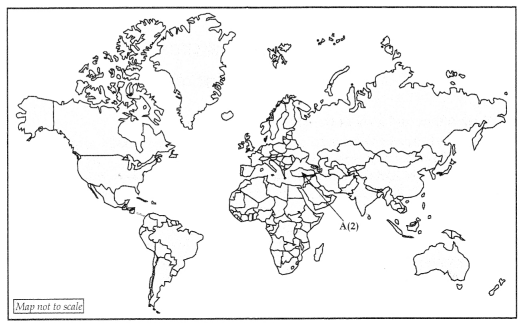
Answer:
(A)
- Russia
- Ottoman Empire
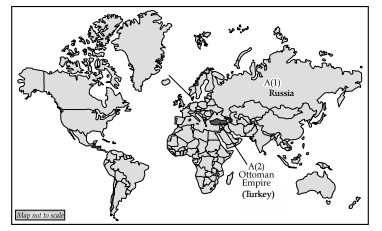
(B)
(1) On the given political map of India, locate and label the following:
(i) The Shiwalik
(ii) Kaziranga National Park
(2) On the outline map of India identify the lake.
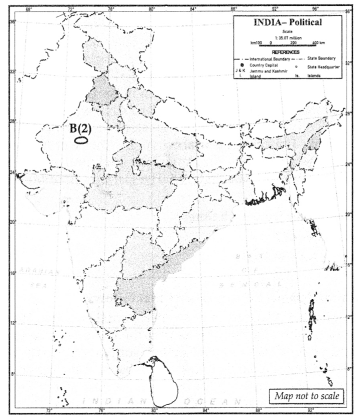
Answer:
(B)
1.
- Shivalik Range
- Kaziranga National Park
2. Sambhar Lake
